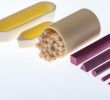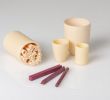Pure alumina and its uses
Alumina is a technical ceramic material suitable for high performance applications such as the defence and aerospace industries, laboratory temperature measurement or high temperature chemical analysis. Ceramic parts are resistant to temperatures up to 1950 °C and to mechanical abrasion. We offer products such as tubes, capillaries, sleeves, crucibles and pods. They can be made of 99.7% pure alumina, dense or porous, or alumina doped with chromium or zirconia.
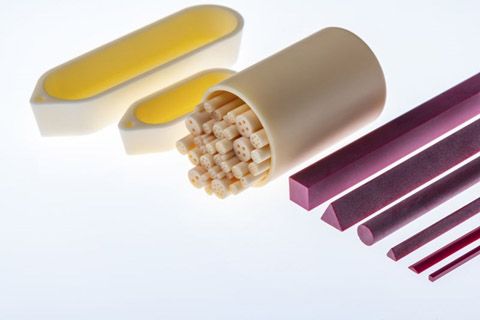
What are the properties of alumina?
Thanks to its melting temperature of over 2000 °C, ceramic alumina offers good resistance to high temperatures and thermal shocks up to 1950 °C. It also has excellent dimensional stability. Aluminium oxide also offers excellent mechanical abrasion resistance, corrosion resistance and wear resistance, which allows it to be used in products and components with a long operational life, ensuring safety and economy.
On the other hand, aluminium oxides are very good electrical insulators. Its electrical conductivity is as low as that of a plastic material. Thus aluminium oxide insulates as well as plastic, even at high temperatures. In addition, it is a good thermal conductor. This makes it an ideal material for insulating temperature measuring devices such as thermocouples.
| Material | F99.7 | F99.7 hf | DEGUSS IT AL23 | DEGUSS IT AL24 | DEGUSS IT AL25 | FZT (ZTA) | DEGUSS IT DD57 |
| Microstructure | |||||||
| Composition (by weight) | > 99,5 % α-Al2O3 | > 99,5 % α-Al2O3 | > 99,5 % α-Al2O3 | > 99,5 % α-Al2O3 | > 99,5 % α-Al2O3 | > 99,5 % α-Al2O3 | > 99,5 % α-Al2O3 |
| Density | >3,90 | >3,90 | 3,70 - 3,95 | >3,40 | >2,80 | >4,05 | >3,90 |
| Open porosity(%) | 0 | 0 | 0 | <5 | 20-30 | 0 | 0 |
| Grain size (µm) | 10 | 10 | 10 | 40 | 70 | 5 | 10 |
| Mechanical properties | |||||||
| Compressive strength (MPa) | 3500 | 3500 | 3500 | 100 | 300 | 3500 | 3000 |
| Flexural strength (MPa) | 350 | 350 | 300-350 | 150 | 70 | 460 | 300 |
| Modulus of elasticity | 380 | 380 | 380 | / | / | 360 | 380 |
| Thermal properties | |||||||
| Maximum operating temperature (°C) | 1950 | 1950 | 1950 | 1950 | 1950 | 1700 | 1950 |
| Specific heat (J/Kg.K) | 900 | 900 | 900 | / | / | 850 | 900 |
| Thermal conductivity at 100 °C (W/m.K) | 34,9 | 34,9 | 34,9 | 27,8 | / | 25 | 34,9 |
| Thermal conductivity at 1000 °C (W/m.K) | 6,8 | 6,8 | 6,8 | 5,5 | / | / | / |
| Coefficient of expansion (10-6/K) | 8,2 | 8,2 | 8,2 | 8,2 | 8,2 | 8,3 | 8,5 |
| Electrical properties | |||||||
| Resistance at 20 °C (ohm.cm) | 1015 | 1014 | / | / | / | / | / |
| Resistance at 1000 °C (ohm.cm) | 107 | 107 | / | / | / | / | / |
| Dielectric strength (kVeff/mm) | >30 | >30 | 20-30 | / | / | / | / |
What are the different types of alumina?
We offer products made of different types of Kyocera alumina. We have pure (99.7%) alumina: C799 (Al2O3) F99.7 dense sintered pure alumina, F99.7 hf alumina, which is mechanically similar to F99.7 alumina but offers, for high frequency applications, a lower dielectric loss tangent as well as a higher relative permittivity DEGUSSIT AL23, DEGUSSIT AL24 and DEGUSSIT AL25 are 99.7% pure alumina, respectively dense, slightly porous or 20-30% porous.
We also offer Zirconia Toughened Alumina (ZTA) type ZrO2. This increases its wear resistance and ensures a very good surface finish. These products can be used for pad printing plates and rollers, flow meters in the chemical industry, pilot pads in the automotive industry or wear plates in the paper industry.
Our superfinishing tools are made of chromium oxide doped alumina: DEGUSSIT DD57 in ruby red colour. This increases the hardness of the material and makes it even more wear-resistant, allowing better finishes and a longer operational life.
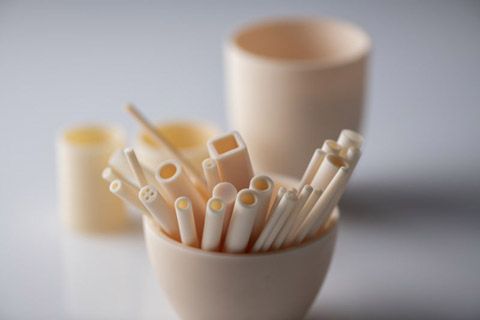
Our standard aluminium oxide products
Our products are manufactured from high-purity Kyocera alumina, either by isostatic pressing or extrusion. Our standard products include a wide range of alumina products. We offer single tubes which can be made of DEGUSSIT AL23 or DEGUSSIT AL24 alumina (improved creep resistance above 1400 °C). We also sell round (with 2, 4, 6 or 8 holes) or oval (with 2 holes) capillaries in DEGUSSIT AL23 alumina.
Our spherical beads and insulating beads are also made of DEGUSSIT AL23 alumina. Our protective sleeves (for cables, thermocouples, etc.) are made of DEGUSSIT AL23 or DEGUSSIT AL24 alumina. We also offer crucibles, which can be conical, cylindrical, with flat or hemispherical bases. Our standard products also include nacelles and combustion boxes which are available in DEGUSSIT AL23, DEGUSSIT AL24 or DEGUSSIT AL25 alumina depending on the porosity required.
We also offer grinding and precision balls, as well as alumina semi-finished products. These semi-finished products include plates, bars and strips which can be made of all types of alumina to best meet the requirements.
Finally, we offer superfinishing tools in DEGUSSIT DD57 chromium doped alumina. The addition of chromium makes the material even harder and more wear-resistant. These tools include files, sharpening stones and grinding wheels.
In addition to these "standard" products, we also offer machining of parts to drawings, so that our customers can obtain the shaped component by machining of their choice.
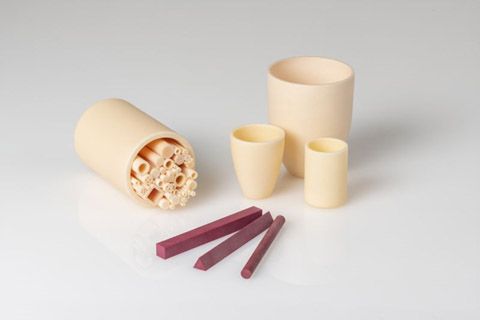
What are the uses of alumina?
Alumina can be used, for example, to manufacture high-temperature components, electrical feedthroughs under vacuum or furnace elements at very high temperatures.
Aluminium oxide can be used in high frequency applications (for radar or microwave components), or in high temperature applications. An important example is the use of alumina for the protection of thermocouples. Thermocouples are temperature measuring instruments. They can measure extreme temperatures by using the Seebeck effect: two metal wires of different types (one platinum, the other platinum-rhodium) are joined together and soldered at one end. The temperature at this end is raised (the temperature to be measured), and this temperature causes an electrical potential difference to appear. Alumina is then used in two different ways: as a capillary and as a sheath. The capillary is used to separate the two metal wires. Since it is an excellent electrical insulator (like plastic), the aluminium oxide prevents any current from flowing between the wires placed in the different holes of the capillary. The sheath, on the other hand, serves to protect the soldered ends from the high temperature environment and/or corrosive products and/or wear. Furthermore, alumina is a good thermal conductor, so the measurement is fast and accurate, and the result is not distorted by the presence of the sheath.





